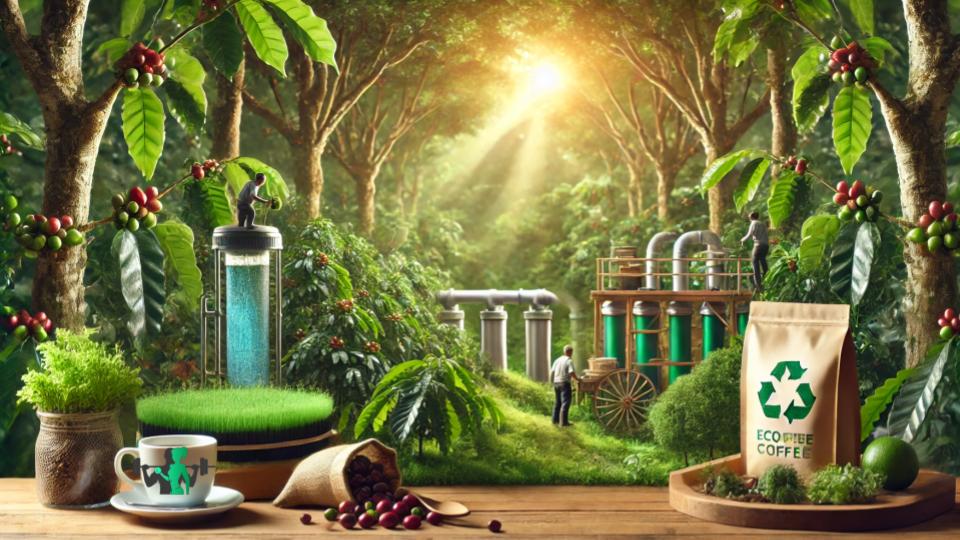Coffee is one of the most traded commodities in the world, but its production has significant environmental impacts. From deforestation to water consumption, coffee farming can take a toll on ecosystems. However, sustainable practices are emerging to reduce coffee’s environmental footprint and ensure a more ethical industry.
In this article, we’ll explore the environmental challenges of coffee production and how sustainable practices are shaping the future of coffee.
1. How Coffee Production Affects the Environment
While coffee is a beloved beverage, its mass production comes with several environmental challenges:
✅ Deforestation and Habitat Loss
- Traditional coffee farms used to grow coffee under shade trees, which preserved biodiversity.
- Modern sun-grown coffee requires cutting down forests, leading to habitat destruction for species like birds, insects, and jaguars.
- Over 2.5 million acres of forest have been cleared for coffee plantations in the last 50 years.
✅ Water Pollution and Overuse
- The washed (wet) coffee process requires large amounts of water.
- In some regions, coffee wastewater is dumped into rivers and lakes, contaminating local ecosystems.
- A single cup of coffee requires 140 liters of water when considering the full production process.
✅ Soil Degradation and Chemical Use
- Large-scale coffee farms use synthetic fertilizers and pesticides, which erode soil quality over time.
- Overuse of chemicals can also pollute groundwater and harm local communities.
These issues highlight the need for more sustainable coffee farming practices.
2. Sustainable Coffee Farming: Eco-Friendly Solutions
To combat these environmental challenges, many coffee producers are adopting sustainable farming practices.
1️⃣ Shade-Grown Coffee (Protecting Forests)
- Instead of clearing forests, some farmers grow coffee under natural tree canopies.
- This method:
✅ Preserves biodiversity
✅ Prevents soil erosion
✅ Provides natural pest control
Regions like Ethiopia and Colombia still practice shade-grown coffee farming, helping maintain native ecosystems.
2️⃣ Organic Coffee Farming (Chemical-Free Production)
- Organic coffee is grown without synthetic pesticides or fertilizers.
- This reduces soil and water pollution while creating a healthier product.
- However, organic coffee farming is more expensive, which is why organic coffee often costs more.
Look for certifications like USDA Organic or EU Organic to ensure coffee is truly organic.
3️⃣ Water-Saving Processing Methods
- The natural (dry) process requires little to no water, reducing pollution.
- Some farms use closed-loop water systems to recycle and filter water before releasing it back into the environment.
- Wet mills in places like Costa Rica have started using water-efficient processing techniques, saving millions of liters per year.
4️⃣ Regenerative Agriculture (Improving Soil Health)
- Some coffee farms are using cover crops, composting, and crop rotation to restore soil health.
- This prevents soil degradation and increases farm productivity over time.
One example is Finca La Soledad in Guatemala, which has successfully restored degraded land using regenerative farming techniques.
3. Certifications: How to Choose Sustainable Coffee
If you want to support eco-friendly coffee, look for certifications that indicate sustainable practices.
Top Sustainable Coffee Certifications:
☕ Rainforest Alliance – Supports biodiversity and fair wages.
☕ Fair Trade Certified – Ensures ethical labor conditions and fair farmer wages.
☕ USDA Organic – Grown without synthetic pesticides or fertilizers.
☕ Bird-Friendly Coffee (Smithsonian) – Shade-grown to protect wildlife habitats.
Buying certified coffee helps promote sustainability and ethical farming.
4. The Future of Sustainable Coffee
With climate change and environmental concerns rising, the coffee industry is working on new sustainable solutions:
✅ Carbon-Neutral Coffee – Some farms are using carbon offset programs to reduce their impact.
✅ Agroforestry Systems – Mixing coffee with other plants like banana trees to enhance biodiversity.
✅ Eco-Friendly Coffee Packaging – More brands are switching to biodegradable or recyclable packaging.
Companies like Nespresso and Illy are investing in reforestation projects and zero-waste packaging, setting new sustainability standards.
Final Thoughts
Coffee farming has serious environmental impacts, but sustainable practices can help protect nature while ensuring a better future for farmers and coffee lovers.
Key Takeaways:
✅ Traditional sun-grown coffee contributes to deforestation.
✅ Water-intensive coffee processing can lead to pollution.
✅ Shade-grown, organic, and regenerative farming are better for the environment.
✅ Certifications like Rainforest Alliance and Fair Trade support sustainable coffee.
✅ The future of coffee includes carbon-neutral farming and eco-friendly packaging.
Next time you buy coffee, check for sustainable labels—your choice can help make coffee more environmentally friendly! ☕🌍
See you.
Read also:

Here we are dedicated to helping you unlock your full potential by focusing on the key pillars of a healthy life: balanced nutrition, restful sleep, mental well-being, and sustainable habits that support long-term health.
